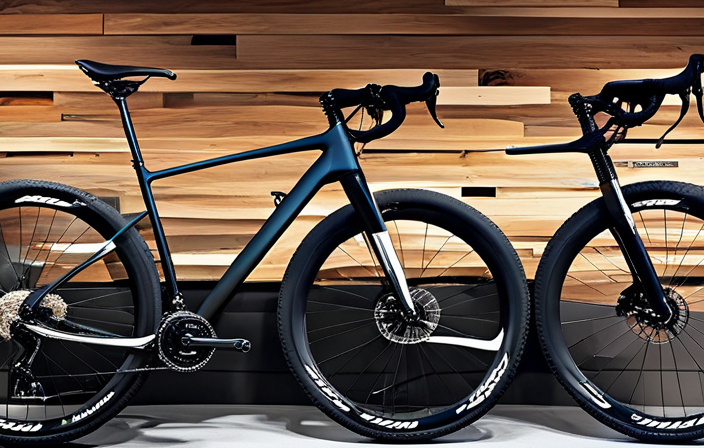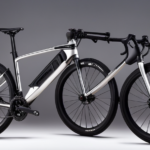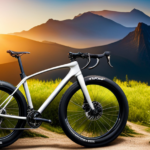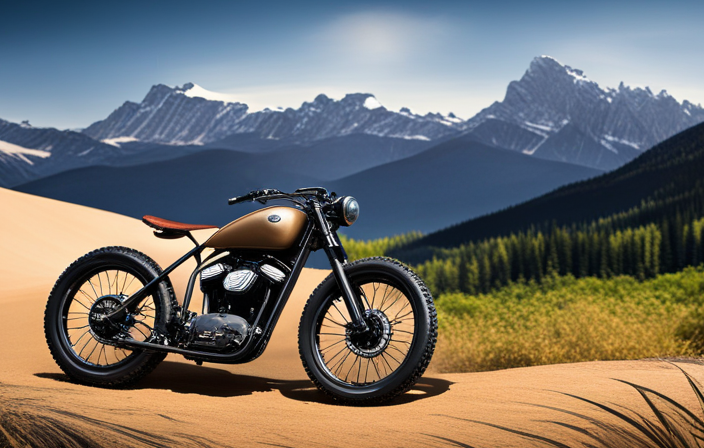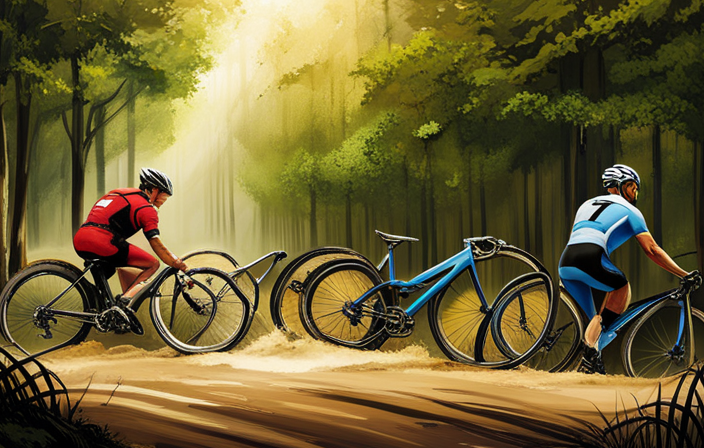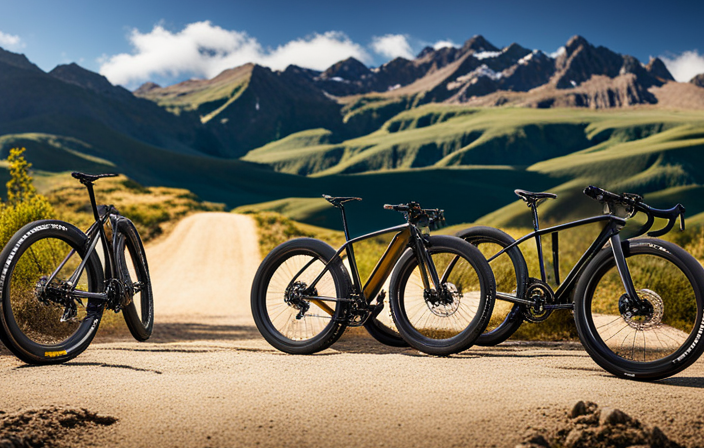Were you aware that the popularity of gravel biking has significantly risen, leading to a 30% increase in gravel bike sales over the last year?
With more and more cyclists venturing off-road, it’s essential to understand what a gravel bike needs to tackle rough terrains effectively.
In this article, we will delve into the technical aspects that make a gravel bike capable of conquering any surface.
From frame geometry and tire clearance to gearing options and brakes, we’ll explore every detail that ensures an exhilarating and smooth ride on your next gravel adventure.
Key Takeaways
- Gravel bikes need a durable frame material such as aluminum, steel, or carbon fiber for durability, comfort, and power transfer.
- Tire and wheelset considerations include tire clearance and width for traction and stability, tubeless setup to prevent flats, and a wide rim for better traction and stability.
- Gearing and pedal options should provide a wide range of gears for climbing and speed maintenance, compatibility with different drivetrain setups, and options for both flat pedals and clipless pedals with cleats and tension adjustments.
- Essential accessories for gravel biking include lights, bike bags, a tire repair kit, a multi-tool, and a water bottle cage, and maintenance tips include regular cleaning, lubrication, tire and brake inspection, and proper bike fit for optimal power transfer and injury prevention.
Frame Geometry
You’ll want a gravel bike with frame geometry that provides a comfortable and stable riding position. The frame material plays a crucial role in achieving this. Gravel bikes are typically made from materials like aluminum, steel, or carbon fiber. Aluminum frames offer durability and affordability, making them a popular choice for riders on a budget. Steel frames, on the other hand, provide excellent comfort due to their natural vibration-damping properties. Carbon fiber frames are lightweight and stiff, offering optimal power transfer.
Next is bike fit, which is essential for long rides on rough terrain. A proper bike fit ensures that your body is positioned optimally for comfort and efficiency. This includes factors such as saddle height, handlebar reach, and stem length. A well-fitted gravel bike allows you to maintain an aerodynamic position while still being able to maneuver easily through challenging terrains.
Moving on to tire clearance – an important consideration when choosing a gravel bike – it determines the width of tires you can use. Gravel roads often feature loose surfaces and uneven terrain; therefore, wider tires with aggressive tread patterns provide better traction and stability. Tire clearance varies among different models, so make sure to choose one that accommodates the desired tire width.
With the right frame geometry and adequate tire clearance, you’ll be ready to tackle any gravel adventure with confidence and ease.
Tire Clearance
Make sure your gravel bicycle has sufficient tire clearance to accommodate wider tires for better off-road traction. Tire clearance refers to the space between the frame and fork of your bike, allowing you to fit larger tires. This is especially important when riding on rough terrain where increased traction and stability are crucial.
To help you understand the importance of tire clearance, let’s take a look at a comparison table:
| Frame Material | Lightweight Aluminum Frame |
|---|---|
| Advantages | – Lighter weight |
| – Stiffness for efficient power transfer | |
| – Durable and resistant to rust or corrosion | |
| Disadvantages | – Less comfortable than carbon fiber frames |
Having a lightweight aluminum frame provides several advantages such as improved maneuverability and easier handling on gravel roads. Additionally, its stiffness allows for efficient power transfer, ensuring every pedal stroke counts.
Ensuring your gravel bike has ample tire clearance will allow you to experience the benefits of wider tires. These benefits include enhanced grip, increased stability, and improved shock absorption over uneven surfaces.
Now that we have covered tire clearance, let’s delve into the next section about gearing options without losing momentum.
Gearing Options
When it comes to gearing options on a gravel bike, there are two key points to consider.
Firstly, a wide range of gears is crucial for tackling both steep climbs and maintaining speed on flat terrain. This allows me to find the perfect gear ratio for any situation, ensuring optimal pedaling efficiency.
Secondly, compatibility with different drivetrain setups is essential as it gives me the flexibility to choose the components that work best for my riding style and preferences. Whether it’s a 1x or 2x setup, having options in terms of gearing allows me to fine-tune my gravel bike to meet my specific needs.
Wide range of gears for climbing and speed
Having a wide range of gears is essential for a gravel bike. It allows for efficient climbing and higher speeds on flat terrain. With a wide range of gears, riders can conquer steep ascents without exerting excessive effort. They can also maintain momentum on descents. Shifting into lower gears provides the necessary torque for tackling challenging uphill sections. This ensures riders can maintain a steady cadence and avoid fatigue. On the other hand, having higher gears enables faster pedaling and increased speed on flatter surfaces or during descents.
The frame geometry of a gravel bike often accommodates multiple chainrings at the front and larger cassettes at the back. This provides an extensive gear range suitable for various terrains. The wide range of gears enhances versatility and ensures optimal performance in different riding conditions.
Another crucial aspect to consider when building a gravel bike is compatibility with different drivetrain setups. Transitioning into compatibility with different drivetrain setups is important.
Compatibility with different drivetrain setups
Ensure that your gravel bike is compatible with a variety of drivetrain setups for maximum versatility and performance.
Drivetrain compatibility is crucial when it comes to gravel riding, as it allows you to choose the components that best suit your needs and preferences. A gravel-specific drivetrain should be able to handle the demands of off-road terrain while providing smooth shifting and reliable performance. Look for features such as wide-range cassettes, clutch derailleurs, and chain guides that prevent chain drops. Additionally, consider whether you want a 1x or 2x setup, depending on your preference for simplicity or wider gear range options.
By selecting gravel specific components that are compatible with different drivetrains, you can ensure optimal functionality and enjoy a seamless riding experience.
Moving forward to the topic of suspension…
Suspension
A gravel bike needs suspension to provide a smoother ride on rough terrain. There are different types of suspension setups that can be used on a gravel bike, depending on the rider’s preferences and the intended use of the bike.
Front Suspension:
- A front suspension setup consists of a suspension fork that absorbs impacts from the front wheel.
- This type of setup is commonly found on mountain bikes and provides better control and comfort when riding over rough surfaces.
Full Suspension:
- A full suspension setup includes both front and rear suspensions, providing enhanced shock absorption.
- This setup is typically used for more extreme off-road riding or when maximum comfort is desired.
Suspension systems can vary in design, including coil spring, air spring, or elastomer-based designs. Each type has its own advantages and disadvantages in terms of weight, adjustability, and performance.
Transitioning into the subsequent section about brakes, it’s important to consider that while suspension helps improve comfort on rough terrain, having reliable brakes is equally crucial for maintaining control and ensuring safety during your gravel adventures.
Brakes
Transitioning to the current subtopic, it’s worth noting that brakes play a crucial role in maintaining control and ensuring safety during gravel riding. When it comes to gravel bikes, there are several factors to consider in order to choose the right brakes for your needs.
Firstly, the frame material of the bike can affect brake performance. A lightweight aluminum frame provides a responsive ride and is often used in entry-level gravel bikes. On the other hand, a carbon frame offers added comfort and stiffness, which can enhance braking efficiency.
Additionally, incorporating a suspension seatpost into your gravel bike setup can improve overall comfort while riding on rough terrain. This feature absorbs vibrations and impacts, allowing you to maintain better control over your bike when applying the brakes.
Furthermore, bike fit plays an important role in optimizing brake performance. Ensuring that your bike is properly fitted to your body proportions allows you to have better leverage and control over the brake levers.
In conclusion, choosing appropriate brakes for your gravel bike involves considering various factors such as frame material, suspension seatpost, and proper bike fit. These elements contribute to maintaining control and ensuring safety during rides on unpredictable terrains.
Moving forward into our next section about ‘wheelset,’ we will explore another essential component of a gravel bike setup.
Wheelset
To choose the right wheelset for your gravel riding needs, consider factors such as weight, durability, and tire compatibility. When it comes to wheelset options for gravel bikes, there are a few key features to look out for.
-
Wide Rim: Opting for a wider rim allows you to run wider tires with lower pressures, providing better traction and comfort on rough terrain. It also increases stability when maneuvering through loose gravel or uneven surfaces.
-
Tubeless Setup: Going tubeless is highly recommended for gravel riding. It eliminates the risk of pinch flats and allows you to run lower tire pressures without sacrificing performance. Look for a wheelset that is compatible with tubeless tires and has a reliable sealing system to ensure hassle-free rides.
-
Sturdy Construction: Gravel riding can be harsh on wheels due to constant vibrations and impacts from rocks and potholes. Choose a wheelset that is built with durability in mind, featuring strong spokes, sturdy hubs, and reinforced rims.
Transition: Now that we have covered the important aspects of selecting a suitable wheelset, let’s move on to discussing another crucial component – handlebars.
Handlebars
One important consideration when choosing handlebars for your gravel riding is comfort. Gravel riding can be long and demanding, so it’s crucial to have handlebars that provide a comfortable and ergonomic position for your hands.
When it comes to frame material, it’s essential to choose handlebars that match the characteristics of your gravel bike’s frame. For example, if you have a carbon fiber frame, you’ll want lightweight handlebars that complement its stiffness and responsiveness. On the other hand, if you have an aluminum frame, you might prefer handlebars with more vibration dampening properties.
Another crucial factor to consider is bike fit. The right handlebars should allow you to achieve a proper fit on your gravel bike. This means finding the right width and shape that suits your body and riding style. Handlebars come in various widths and shapes such as drop bars or flat bars, each offering different benefits depending on the type of terrain you ride on.
In conclusion, choosing the right handlebars for your gravel bike involves considering factors such as comfort, frame material compatibility, and bike fit. These elements are vital in ensuring an enjoyable and efficient riding experience on varied terrains. Once you have selected the appropriate handlebars for your needs, it’s time to explore accessories that can enhance your gravel riding experience.
Accessories
Now that you’ve chosen the right handlebars for your gravel bike, it’s time to explore accessories that can enhance your riding experience. These essential add-ons not only improve functionality but also contribute to your safety and convenience on the road.
Here are five must-have accessories for your gravel bike:
-
Bike lights: When riding in low-light conditions or at night, having reliable bike lights is crucial. Opt for powerful LED lights with both front and rear options to ensure maximum visibility and safety.
-
Bike bags: Gravel biking often involves long rides where carrying essentials becomes necessary. Invest in a quality bike bag that provides ample storage space without compromising balance or aerodynamics. Look for waterproof options with multiple compartments to keep your belongings organized and protected from the elements.
-
Tire repair kit: Flat tires are an unfortunate reality of gravel biking. Be prepared by carrying a tire repair kit containing patches, tire levers, a mini-pump, and spare tubes. This will save you from being stranded miles away from help.
-
Multi-tool: A compact multi-tool is indispensable for any rider. It allows you to make quick adjustments or repairs on the go, ensuring your bike remains in optimal condition throughout your journey.
-
Water bottle cage: Staying hydrated during long rides is vital. Install a sturdy water bottle cage on your gravel bike frame so that you can easily access hydration whenever needed.
Now let’s delve into the next section about gravel-specific components without delay.
Gravel-specific Components
Gravel-specific components are designed to enhance your riding experience on rough terrain. One important component to consider is gravel specific tires. These tires have a wider tread pattern and more aggressive knobs compared to standard road bike tires. This provides better traction and control when riding on loose surfaces like gravel or dirt. Additionally, gravel specific tires often have a tubeless setup option, which eliminates the need for inner tubes and reduces the risk of pinch flats. Tubeless tires can be run at lower pressures, improving comfort and grip on uneven surfaces.
Another key component to consider is the frame material of your gravel bike. Carbon fiber frames are popular due to their light weight and ability to dampen vibrations from rough roads. They also offer excellent power transfer for efficient pedaling. However, aluminum frames are also a good choice for their durability and affordability.
Transitioning into the next section about frame material, it’s important to choose the right one that suits your riding style and preferences.
Frame Material
When it comes to frame material for gravel bikes, there are two key options that provide different benefits.
The first is a lightweight aluminum frame, which offers great durability and affordability while still maintaining a reasonable weight.
On the other hand, a carbon frame is known for its added comfort and stiffness, making it a popular choice among serious gravel riders looking for optimum performance.
Both options have their advantages depending on your specific needs and preferences in terms of weight, comfort, and overall ride quality.
Lightweight aluminum frame
A gravel bike needs a lightweight aluminum frame for improved performance. Aluminum is a popular choice for gravel bike frames due to its excellent strength-to-weight ratio. Here are four reasons why a lightweight aluminum frame is essential:
-
Durability: Aluminum frames are known for their durability, making them suitable for rough terrain and off-road adventures.
-
Responsiveness: The stiffness of aluminum allows for efficient power transfer, enhancing the bike’s responsiveness and acceleration.
-
Affordability: Compared to carbon frames, aluminum frames are more budget-friendly while still providing high performance.
-
Versatility: Aluminum frames can be designed with various geometries, allowing riders to find the perfect fit and ride style.
Transitioning into the next section about carbon frames, they offer added comfort and stiffness for even greater performance on gravel roads.
Carbon frame for added comfort and stiffness
To enhance your riding experience on gravel roads, consider opting for a carbon frame that offers added comfort and stiffness.
A carbon frame has numerous benefits for gravel biking enthusiasts. Firstly, it provides superior vibration damping properties compared to aluminum frames, resulting in a smoother ride over rough terrain.
Additionally, carbon frames are known for their excellent power transfer capabilities due to their high stiffness-to-weight ratio. This means that more of your energy is efficiently transferred into forward motion, resulting in increased speed and less fatigue during long rides.
Furthermore, carbon frames allow for greater customization options when it comes to geometry and design features, ensuring a bike that perfectly suits your preferences and riding style.
With all these advantages in mind, let’s now delve into the importance of selecting the right pedals for your gravel bike…
Pedals
Pedals on a gravel bike need to be durable and provide good grip. When it comes to choosing the right pedals for your gravel bike, there are several factors to consider. First and foremost, you want pedals that will withstand the rigors of off-road riding and not break or wear out easily. Additionally, having good grip is essential for maintaining control over rough terrain.
To help you make an informed decision, I have created a table outlining some popular pedal options for gravel bikes:
| Pedal Type | Features | Pros | Cons |
|---|---|---|---|
| Flat Pedals | – Wide platform |
- Adjustable pins
- Easy entry/exit | – Suitable for all shoe types
- No special shoes required
- Quick foot adjustment | – Less efficient power transfer compared to clipless pedals |
| Clipless Pedals | – Secure attachment with cleats - Efficient power transfer
- Multiple tension adjustments | – Increased pedaling efficiency
- Enhanced control on technical terrain | – Requires specific cycling shoes
- Initial learning curve |
Choosing between flat pedals and clipless pedals ultimately depends on your personal preference and riding style. Keep in mind that whichever option you choose, proper bike fit is crucial for optimal performance and comfort.
Now let’s transition into discussing another important component of a gravel bike: the saddle.
Saddle
When choosing the right saddle for your gravel bike, comfort and support are key factors to consider. A well-fitted saddle can make all the difference in your riding experience, ensuring that you stay comfortable even on long rides. Bike fit is crucial when selecting a saddle as it should be compatible with your body geometry and riding style. It’s important to take into account your sit bone width and find a saddle that matches it.
Additionally, maintenance and upkeep of the saddle are essential for its longevity. To ensure optimal performance, regular cleaning and lubrication of the saddle rails is necessary. This helps prevent rusting or seizing of the components over time. Furthermore, checking for any signs of wear or damage is vital to address any issues before they become major problems.
Transitioning into the subsequent section about suspension seatposts, it’s worth noting that some riders may opt for this additional feature to further enhance comfort and reduce vibrations while riding on rough terrain. The combination of a well-fitted saddle and a suspension seatpost can provide an even smoother ride, especially when exploring off-road trails or tackling uneven surfaces.
Suspension Seatpost
The suspension seatpost enhances comfort and reduces vibrations for a smoother ride on rough terrain. It is an essential component of a gravel bike, as it provides the rider with added shock absorption and increased stability. With its ability to absorb impacts and vibrations, the suspension seatpost ensures that the rider stays comfortable even on bumpy surfaces.
Here are four key features that make a suspension seatpost an indispensable part of a gravel bike:
-
Adjustability: Suspension seatposts often come with adjustable settings, allowing riders to fine-tune their preferences based on terrain conditions and personal comfort.
-
Spring system: Equipped with a spring mechanism, the suspension seatpost effectively absorbs shocks and bumps encountered during off-road adventures.
-
Damping properties: The damping characteristics of a suspension seatpost determine how it responds to sudden impacts. A well-designed damping system helps maintain control over the bike while minimizing discomfort.
-
Weight consideration: While providing comfort is crucial, it’s equally important for a gravel bike to be lightweight. Many manufacturers have successfully achieved this balance by utilizing lightweight materials without compromising performance.
Considering these factors, investing in a quality suspension seatpost can significantly enhance your riding experience by ensuring optimal comfort enhancement and shock absorption.
Transitioning into the subsequent section about ‘bike fit,’ it is vital to ensure your gravel bike fits you perfectly for maximum performance and efficiency.
Bike Fit
To optimize your riding experience and prevent discomfort, it’s important to ensure that your gravel bike fits you perfectly. Bike fit plays a crucial role in your overall performance and comfort on the bike. Proper bike sizing ensures that you are able to generate power efficiently, maintain a comfortable riding position, and reduce the risk of injury.
When it comes to bike fit, there are several key measurements and adjustments to consider. These include saddle height, reach (the distance from the saddle to the handlebars), stack (the vertical distance from the bottom bracket to the top of the head tube), and frame size. Getting these measurements right will help you achieve an optimal riding position that maximizes power transfer while minimizing strain on your body.
To help you understand how these measurements impact your bike fit, take a look at this table:
| Measurement | Ideal Range |
|---|---|
| Saddle Height | X – Y cm |
| Reach | A – B cm |
| Stack | P – Q cm |
| Frame Size | M / L / XL |
By following proper bike sizing guidelines and making necessary adjustments, you can ensure a comfortable ride with efficient power transfer. This will allow you to fully enjoy your gravel biking adventures. Now let’s move on to maintenance and upkeep for your gravel bike.
SUBSEQUENT SECTION: ‘Maintenance and Upkeep’
Maintenance and Upkeep
Proper maintenance and upkeep are essential for ensuring the longevity and performance of your gravel bike. To keep your bike in top shape, here are some maintenance tips to consider.
Regular cleaning is crucial to prevent dirt and grime buildup. After each ride, give your bike a thorough wash using mild soap and water. Pay extra attention to the drivetrain, as it tends to accumulate the most debris. Lubricating the chain regularly with a suitable lubricant is also important to minimize friction and extend its lifespan.
Inspecting your bike for any signs of wear or damage is another vital aspect of maintenance. Check the tires for cuts or punctures that may lead to flats during rides. Additionally, inspect the brake pads for wear and adjust them if necessary. Keep an eye on the shifting performance of your gears too, as poor shifting can indicate issues with cable tension or derailleur alignment.
Common issues that gravel bikes face include loose bolts, squeaky brakes, and worn-out components such as chains or cassettes. It’s important to address these problems promptly before they worsen or compromise your riding experience.
By following these maintenance tips and addressing common issues promptly, you can ensure that your gravel bike remains reliable and performs at its best for many rides to come.
Frequently Asked Questions
What is the ideal tire pressure for a gravel bike?
The ideal tire pressure for a gravel bike depends on various factors, such as rider weight, terrain, and personal preference.
Generally, a lower tire pressure is recommended for better traction and comfort on rough surfaces. However, it’s important to strike a balance to avoid pinch flats or loss of control.
Regular tire maintenance is crucial, including checking the pressure before every ride and adjusting it accordingly. This ensures optimal performance and enhances the overall riding experience.
How often should I clean and lubricate the drivetrain of my gravel bike?
I recommend cleaning and lubricating the drivetrain of your gravel bike every 100-200 miles, or whenever it becomes noticeably dirty or noisy.
Regular maintenance helps to prolong the life of your components and ensures smooth operation.
When cleaning, use a degreaser to remove built-up grime and dirt, then dry thoroughly before applying the recommended lubricant.
I suggest using a high-quality chain lube designed specifically for dusty off-road conditions to minimize wear and maintain optimal performance.
Can I use a road bike helmet for gravel riding or do I need a specific type of helmet?
Yes, a road bike helmet can be used for gravel riding, although it’s recommended to use a helmet specifically designed for gravel biking.
Gravel bike helmets offer additional features to enhance safety and comfort on rough terrain. These helmets typically have increased coverage, improved ventilation, and enhanced impact protection. They also often include visors or integrated camera mounts for added convenience.
So while a road bike helmet can suffice, investing in a gravel bike helmet will provide better performance and protection.
Are tubeless tires necessary for gravel riding, or can I use traditional clincher tires?
Tubeless vs clincher tires is a common debate among gravel riders. Tubeless tires offer several advantages, including reduced risk of flats, increased traction, and the ability to run lower pressures for better comfort and control. They require specific rims and sealant to set up properly.
On the other hand, traditional clincher tires are easier to install and maintain but are more prone to punctures.
Ultimately, the choice between tubeless and clincher tires depends on your riding style and preferences.
Are there any specific riding techniques or skills I should learn for gravel riding?
Gravel riding requires a unique set of skills and techniques to handle the bike effectively. When navigating unpredictable terrain, it’s crucial to maintain balance and control. Proper body positioning, weight distribution, and smooth pedal strokes are essential for stability.
Additionally, mastering cornering on loose surfaces is key to maintaining speed and control. As for essential gear, a gravel bike should be equipped with wider tires for improved traction, disc brakes for reliable stopping power, and a comfortable saddle for long rides.
Conclusion
In conclusion, the gravel bike is a versatile and essential tool for any adventurous cyclist. With its unique frame geometry, tire clearance, and wide range of gearing options, it can tackle any terrain with ease.
The addition of suspension and reliable brakes ensures a smooth and controlled ride. A comfortable saddle and suspension seatpost provide optimal comfort during long rides.
Remember to always prioritize proper bike fit and regular maintenance to keep your gravel bike in top shape. So, hop on your trusty steed and explore the trails like a true trailblazer!

